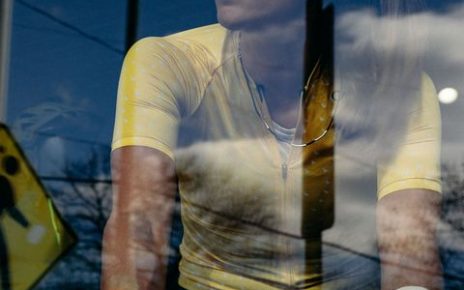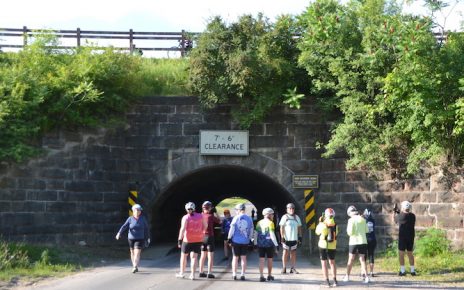CLEVELAND, Ohio — It’s been obvious for years to commercial real estate broker and dedicated jogger Conor Coakley that Cleveland should have a 3-mile recreational loop connecting the Ohio City neighborhood to downtown via bridges over the Cuyahoga River.
With skyline views and vistas of the Flats along the river, such a route would be a handsome amenity for a Midwest industrial city striving for revitalization.
Last year, Coakley and a team of volunteer executives and architects associated with the nonprofit group Leadership Cleveland unveiled a proposal showing how such a loop could be created at relatively low cost, in part by re-striping Huron Road behind Tower City Center to create a track for cyclists and runners.
But a recently completed $13 million repaving project omitted a bike path, leaving a 2,200-foot-long gap on the east side of the river between paths that now traverse the Detroit-Superior and Lorain-Carnegie bridges.

Conor Coakley, of Leadership Cleveland, stands on Onstario St. near Huron Rd. Coakley led a proposal in 2019 to create a formal running-bike-recreation path looping downtown’s bridges and great skyline views. The city repaved part of Huron Road (indicated by orange barrels to the left of Coakley) without a bike lane.The Plain Dealer
“It just gets frustrating that we lose these opportunities,’’ said Ward 12 Councilman Tony Brancatelli, chair of City Council’s Development, Planning and Sustainability Committee.
Reviewing performance
The failure to create a downtown loop is an example of the mixed record of Mayor Frank Jackson’s administration in observing the city’s 2011 “Complete and Green Streets” ordinance, Brancatelli and others say.
Modeled on similar initiatives in cities across the country, the legislation takes the view that streets can do much more than merely move traffic. That’s especially true in Cleveland, a city in which declining population has left streets oversized in relation to the diminished traffic loads they carry.
The ordinance authorized repaving or road reconstruction projects to include bike lanes and pedestrian amenities such as wheelchair ramps and “bump outs’’ at intersections, which shorten walking distances across streets. It also called for green infrastructure, which can add shade and soak up storm runoff, while beautifying streets.
But the legislation lacked mechanisms to require action or transparency, said Ward 3 Councilman Kerry McCormack, whose ward includes downtown and Ohio City.
Instead, he said, the administration has made too many decisions on street projects in-house, sometimes without consulting neighborhoods or council representatives far enough in advance to enable changes in design.
Observers say the only project to receive a full “complete and green” treatment since 2011 is the mile-long, $8.5 million reconstruction of Fleet Avenue in Slavic Village, in Brancatelli’s Ward, completed in 2016.
Lost opportunities
Bike Cleveland, the city’s leading advocacy group for bicyclists, with over 1,000 members, compiled a map last year detailing missed opportunities. It shows that of 66 repaving projects completed on 78 miles of major streets since 2012, 19 projects totaling nearly 23 miles, or 29.5%, didn’t get bike paths and received only minimal “complete and green’’ elements.
Those projects included portions of Lakeside Avenue, East 9th Street, Pearl Road, East 55th Street, Cedar Road and Woodland Avenue.
Elsewhere, bike lanes created by the city are uneven in design quality or have failed so far to create a network, said Jacob VanSickle, Bike Cleveland’s executive director.
“If you’re not thinking in terms of a network, you’re not going to get people out riding, and it’s all for naught,’’ VanSickle said.
As for design, Van Sickle and other critics point to a 2015 repaving project on West 25th Street that included bike lanes between Bridge and Detroit avenues with buffered zones at the curb, guiding bicycles to ride closer to traffic instead of farther away. (A buffered zone is striped to indicate that riders and cars should stay out).
Of the city’s record on complete and green streets, McCormack said: “Legislation is useless unless it’s producing the results in the community it is intended to produce.’’
Revision in the works
The councilman plans to introduce revisions to the ordinance this spring that would create an oversight commission, with a majority of appointments made by Council. Members would include representatives of the Northeast Ohio Regional Sewer District and the Northeast Ohio Areawide Coordinating Agency, which guides federal and state spending on transportation in the region.
Darnell Brown, the city’s chief operating officer, and Freddy Collier, its planning director, disputed the criticisms in an interview Wednesday.
They said the city deserves more credit for what it has accomplished in recent years by repaving streets and adding nearly all 70 miles of bike routes specified in its 2007 Bikeway Master Plan. Additional bike routes will be considered as part of a comprehensive city plan update beginning in 2021, Collier said.
Brown said the administration collaborates with residents, outside agencies and members of council on street projects.
Response to critique
“We can’t reconstruct or redo a street or resurface a street without going over to Council and getting a piece of legislation passed,’’ he said. “There’s always lots of advance notice on when these things are occurring.”
Road projects differ in scope and scale, and that some are more appropriate for complete and green elements than others, he said.
McCormack, Brancatelli and other observers said in the administration’s favor that it has worked hard on certain projects to follow the streets ordinance.
The administration has included a bike path as part of the upcoming Opportunity Corridor boulevard. It is spearheading a project to transform more than 2 miles of Superior Avenue from Public Square to East 55th Street with the $16 million “Midway,’’ the first leg of a proposed citywide system of bicycle thoroughfares that would occupy parts of streets once used by streetcars. Construction could begin in 2021.
A similar project on Lorain Avenue, would extend a cycle track from West 20th to West 65th Street and could start as soon as 2022.
Not all such projects need to be costly. In 2017, bike enthusiasts applauded the city for spending $81,000 to add bike lanes to the Detroit Superior Bridge, including an eastbound lane separated from traffic by curbs, stripes and delineator posts.
Vision Zero
Also on the plus side, the Jackson administration is participating on the Vision Zero traffic safety task force created in 2018 by City Council, headed by Ward 15 Councilman Matt Zone.
The project takes inspiration from a global movement launched in Sweden in 1995, aimed at shifting responsibility for safety from road users to road designers.
Zone said the group will soon seek a consultant to study how the city can improve its practices.
The Vision Zero group also has provided feedback on the proposed revisions to the complete and green street ordinance, McCormack said. But he wants to have the new legislation adopted now, not after the Vision Zero task force completes its work.
“I don’t want to wait for a consultant to come on board, and for months and months and months to go by before we have this conversation,” he said.
Coakley, meanwhile, still regrets that the Huron Road rehab failed to incorporate the concept for a loop trail.

A 2019 rendering by the Cleveland architecture firm of AoDK Inc., Architecture depicts a concept for a portion of a proposed downtown recreational loop for cyclists and joggers that would connect downtown to Ohio City. Advocates say Cleveland missed the opportunity to create a portion of the new trail on a recently repaved section of Huron Road behind Tower City Center. They’d like to see the city’s “Complete and Green Streets” ordinance updated to improve the chances that such projects could become a reality.AoDK Architects
He said he consulted most property owners along the proposed 3-mile loop last year, and they were enthusiastic about the idea.
“Everyone was like, ‘hey this is great what can we do?’ ” he said. But he said the Jackson administration never gave it serious consideration.
When asked whether he’d agree to discuss the proposal, Brown said, “I’m still willing to meet if they want to meet.”
Read more:
Red Line Greenway trail shows great promise
Beacon apartment tower’s facade most visually dynamic architecture in new downtown skyline
Sherwin-Williams new HQ should create positive ripples downtown


